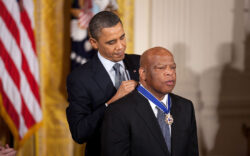March is Women’s History Month, an annual observance of the courage, commitment and contributions of women worldwide. Though American women did not get the right to vote nationwide until 1920, in the last century they have excelled at professions from astronaut to zoologist. In the world of journalism, women have made their mark for decades, and the crusading female reporter is a part of American popular culture.
From 1940–2011, the adventures of “Brenda Starr, Reporter” were featured on the comics pages of 250 American newspapers. Created by cartoonist Dalia Messick, Starr was a glamorous, red-haired reporter who used her looks and street savvy to chase criminals and expose corruption. In the fictional newsroom of The Daily Planet, Lois Lane was a reporter alongside Clark Kent. Though she had a nose for news in her role in comic books, movies and TV shows, Lois never noticed that “mild-mannered reporter” Clark Kent was actually “the man of steel”—Superman.
Television drama entered the newsroom in the series “Lou Grant,” which ran on CBS from 1977–1982. Ed Asner played the part of a gruff editor at a Los Angeles newspaper. Robert Walden was cast as a young reporter with both ego and accomplishments who sparred with his coworker, Billie Newman, an able and ambitious newswoman who chafed at the lingering sexism in newsrooms. “Lou Grant” should be required viewing for journalism classes today.
In real life, women journalists have been role models for all news writers. Nellie Bly (1864–1922) was one of the original muckraking journalists whose work led to much-needed changes in the Gilded Age. In 1887 she posed as a mentally ill person and spent 10 days inside the walls of a New York asylum that she called “a human rat trap.” Her reporting led to reforms in the state’s treatment of the mentally ill. In 1889 she wrote a happier story when, pre-airplane, she traveled around the world in 72 days, beating the record achieved in the fiction of Jules Verne’s classic novel Around the World in Eighty Days.
“I was too impatient to work at the usual duties assigned to women in newspapers,” said Bly. “I have never written a word that did not come from my heart. I never shall.”
Her journalistic contemporary, Ida Tarbell, would agree. Tarbell (1857–1944) was a pioneer of investigative journalism who exposed the rapaciousness of plutocrat John D. Rockefeller’s Standard Oil corporation. She was a tenacious writer and researcher who said, “Imagination is the only key to the future. Without it, none exists. With it, all things are possible.”
Ida B. Wells (1862–1931) was born into slavery during the Civil War. She earned her greatest fame by exposing the epidemic of lynching in 19th century America. “The people must know before they can act, and there’s no educator to compare with the press,” she maintained.
Nora Sayre (1932–2001) was a prolific writer for newspapers and magazines whose 1973 book, Sixties Going On Seventies, is an insider’s account of the hopes and fears of a tempestuous time in America. Sayre embedded herself in protest marches and rallies, and her accounts from inside those events brought the smell of tear gas and the sight of bloody streets onto the printed page. “There’s no choice but to give the whole picture,” she wrote.
Helen Thomas (1920–2013) was the first female member of the White House press corps. She covered every president from John F. Kennedy to Barack Obama. An Arab American, she angered the George W. Bush administration with her opposition to the Iraq war, and in 2010 she resigned from her post after her comments against the Israeli government ignited a firestorm of protest. “Every president hates the press,” she said.
Molly Ivins (1944–2007) also sparred with Bush, her fellow Texan. “Keep fighting for freedom and justice,” she said, “but don’t forget to have fun doing it.”
Celestine Sibley (1914–1999) was an icon of Atlanta journalism who wrote that “Being a reporter is one of the noblest things you can do in life.”
Here in Athens, Conoly Hester (1934–2021) brought nobility to local journalism during her decades of service at the Athens Observer and the Athens Banner-Herald. When she died, longtime local reporter Lee Shearer said that she had “intelligence, courage and heart, and was meticulous in her craft.” Indeed, Hester earned her place as a pioneering journalist in search of truth.
Like what you just read? Support Flagpole by making a donation today. Every dollar you give helps fund our ongoing mission to provide Athens with quality, independent journalism.









